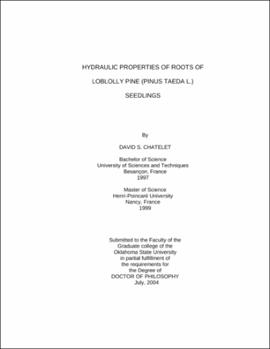| dc.contributor.advisor | Hallgren, Stephen W. | |
| dc.contributor.author | Chatelet, David S. | |
| dc.date.accessioned | 2013-11-26T08:26:08Z | |
| dc.date.available | 2013-11-26T08:26:08Z | |
| dc.date.issued | 2004-07 | |
| dc.identifier.uri | https://hdl.handle.net/11244/6842 | |
| dc.description.abstract | Scope and Method of Study: Loblolly pine root system is composed of a vertical taproot (TAPR), horizontal first-order lateral roots (FOLRs) and second-order lateral roots (SOLRs). Each root is composed of anatomically different zones (white, condensed tannin (CT) and cork). Changes occurring in the anatomy and morphology of these roots have a decisive role in the movement of water and ions. The objective was to quantify limitations to water uptake of P. taeda root systems, by investigating (1) the changes in the root system morphological parameters during its first year of growth, (2) the seasonal changes in the tracheid traits and the resistance of each tracheid component to the total tracheid resistance, and (3) the changes in hydraulic conductivity during root growth and development. Seedling root systems were harvested monthly in the nursery using PVC pipes. Based on zones and root type, root system morphology was measured, tracheids were studied under bright-field microscope and SEM and hydraulic conductivity was quantified. | |
| dc.description.abstract | Findings and Conclusions: The white zone was not a major component of the root system length or surface area. Its role may be more essential for ion than water uptake. The CT zone was more important, implying a more significant role in water uptake. Lateral roots represented most of the length and surface area of the root system. Tracheids were longer and wider in the CT and cork zones and their number also increased from the white to the cork zone to accommodate increasing water flow. The bordered pit dimensions remained constant between zones and throughout the growing season. Pit resistance represented 82 to 97% of the tracheid resistance. TAPR tracheid resistance was constant over the growing season despite the increase in diameter. Conductivity varied according the zone anatomical characteristics. Tracheid conductivity was the limiting factor to the axial conductivity. Predicted root system conductivity decreased throughout the season. Most of the water was absorbed by the CT and cork zones. | |
| dc.format | application/pdf | |
| dc.language | en_US | |
| dc.rights | Copyright is held by the author who has granted the Oklahoma State University Library the non-exclusive right to share this material in its institutional repository. Contact Digital Library Services at lib-dls@okstate.edu or 405-744-9161 for the permission policy on the use, reproduction or distribution of this material. | |
| dc.title | Hydraulic properties of roots of loblolly pine (Pinus taeda L.) seedlings | |
| dc.contributor.committeeMember | Martin, Bjorn | |
| dc.contributor.committeeMember | Hennessey, Thomas C. | |
| dc.contributor.committeeMember | Rikin, Arnon | |
| osu.filename | Chatelet_okstate_0664D_1074 | |
| osu.accesstype | Open Access | |
| dc.type.genre | Dissertation | |
| dc.type.material | Text | |
| dc.subject.keywords | roots | |
| dc.subject.keywords | loblolly pine | |
| dc.subject.keywords | seedlings | |
| dc.subject.keywords | pinus taeda | |
| thesis.degree.discipline | Plant Science | |
| thesis.degree.grantor | Oklahoma State University | |
